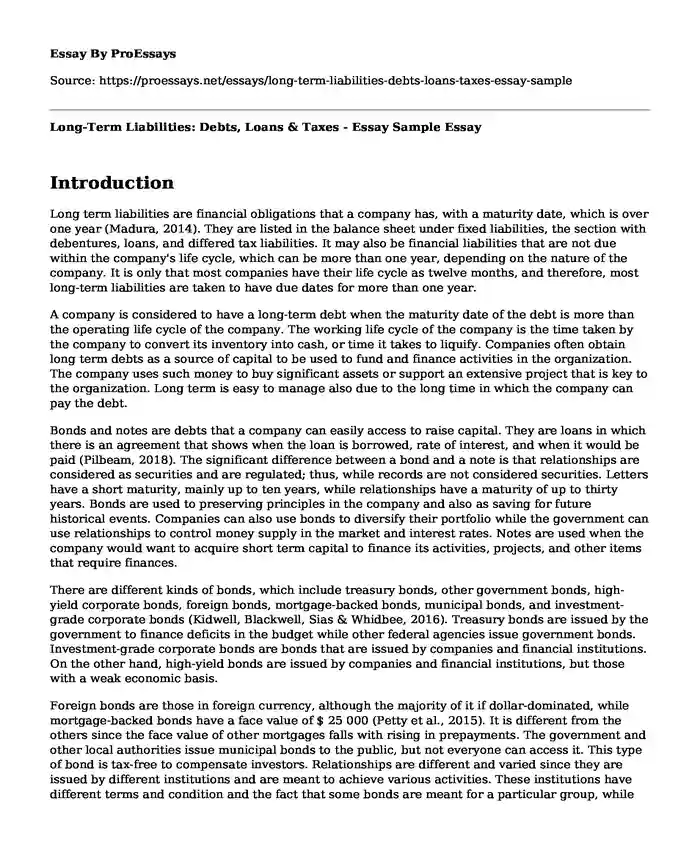Introduction
Long term liabilities are financial obligations that a company has, with a maturity date, which is over one year (Madura, 2014). They are listed in the balance sheet under fixed liabilities, the section with debentures, loans, and differed tax liabilities. It may also be financial liabilities that are not due within the company's life cycle, which can be more than one year, depending on the nature of the company. It is only that most companies have their life cycle as twelve months, and therefore, most long-term liabilities are taken to have due dates for more than one year.
A company is considered to have a long-term debt when the maturity date of the debt is more than the operating life cycle of the company. The working life cycle of the company is the time taken by the company to convert its inventory into cash, or time it takes to liquify. Companies often obtain long term debts as a source of capital to be used to fund and finance activities in the organization. The company uses such money to buy significant assets or support an extensive project that is key to the organization. Long term is easy to manage also due to the long time in which the company can pay the debt.
Bonds and notes are debts that a company can easily access to raise capital. They are loans in which there is an agreement that shows when the loan is borrowed, rate of interest, and when it would be paid (Pilbeam, 2018). The significant difference between a bond and a note is that relationships are considered as securities and are regulated; thus, while records are not considered securities. Letters have a short maturity, mainly up to ten years, while relationships have a maturity of up to thirty years. Bonds are used to preserving principles in the company and also as saving for future historical events. Companies can also use bonds to diversify their portfolio while the government can use relationships to control money supply in the market and interest rates. Notes are used when the company would want to acquire short term capital to finance its activities, projects, and other items that require finances.
There are different kinds of bonds, which include treasury bonds, other government bonds, high-yield corporate bonds, foreign bonds, mortgage-backed bonds, municipal bonds, and investment-grade corporate bonds (Kidwell, Blackwell, Sias & Whidbee, 2016). Treasury bonds are issued by the government to finance deficits in the budget while other federal agencies issue government bonds. Investment-grade corporate bonds are bonds that are issued by companies and financial institutions. On the other hand, high-yield bonds are issued by companies and financial institutions, but those with a weak economic basis.
Foreign bonds are those in foreign currency, although the majority of it if dollar-dominated, while mortgage-backed bonds have a face value of $ 25 000 (Petty et al., 2015). It is different from the others since the face value of other mortgages falls with rising in prepayments. The government and other local authorities issue municipal bonds to the public, but not everyone can access it. This type of bond is tax-free to compensate investors. Relationships are different and varied since they are issued by different institutions and are meant to achieve various activities. These institutions have different terms and condition and the fact that some bonds are meant for a particular group, while some are open to everyone.
References
Kidwell, D. S., Blackwell, D. W., Sias, R. W., & Whidbee, D. A. (2016). Financial institutions, markets, and money. John Wiley & Sons.
Madura, J. (2014). Financial markets and institutions. Nelson Education.
Pilbeam, K. (2018). Finance & financial markets. Macmillan International Higher Education.
Petty, J. W., Titman, S., Keown, A. J., Martin, P., Martin, J. D., & Burrow, M. (2015). Financial management: Principles and applications. Pearson Higher Education AU.
Cite this page
Long-Term Liabilities: Debts, Loans & Taxes - Essay Sample. (2023, Mar 20). Retrieved from https://proessays.net/essays/long-term-liabilities-debts-loans-taxes-essay-sample
If you are the original author of this essay and no longer wish to have it published on the ProEssays website, please click below to request its removal:
- Business Paper Sample - Cost Estimating in the Acquisition Field
- Wells Fargo Scandal Essay Example
- Digital Disruptions in the Banking Industry Paper Example
- Rhetorical Analysis Essay: Is It Necessary to Have Health Insurance
- Financial Management Challenge Case Study
- Blockchain: Transforming Industries and Sparking Innovative Discussions - Essay Sample
- Report Example on International Business: Intangible Assets & Cost







